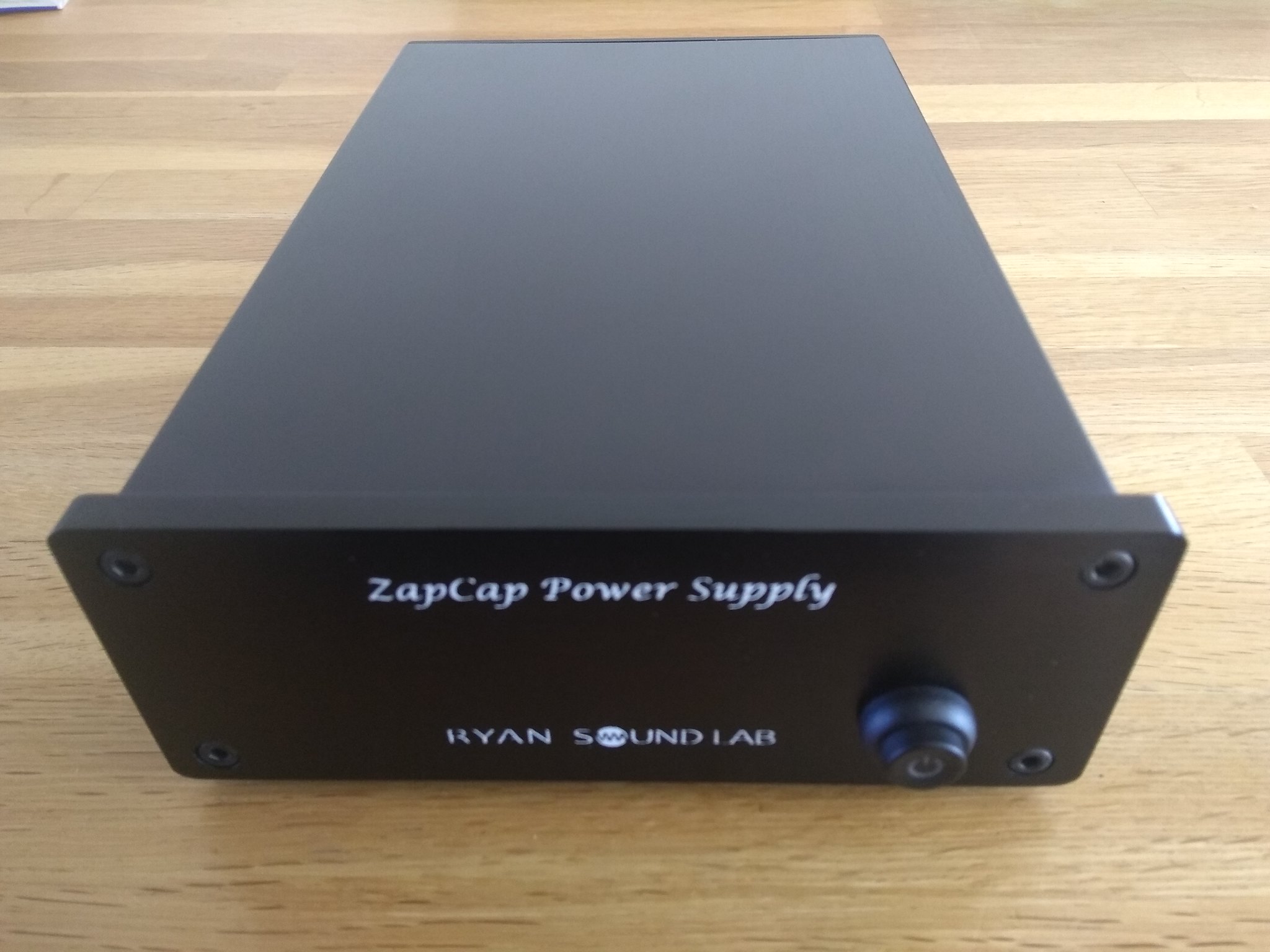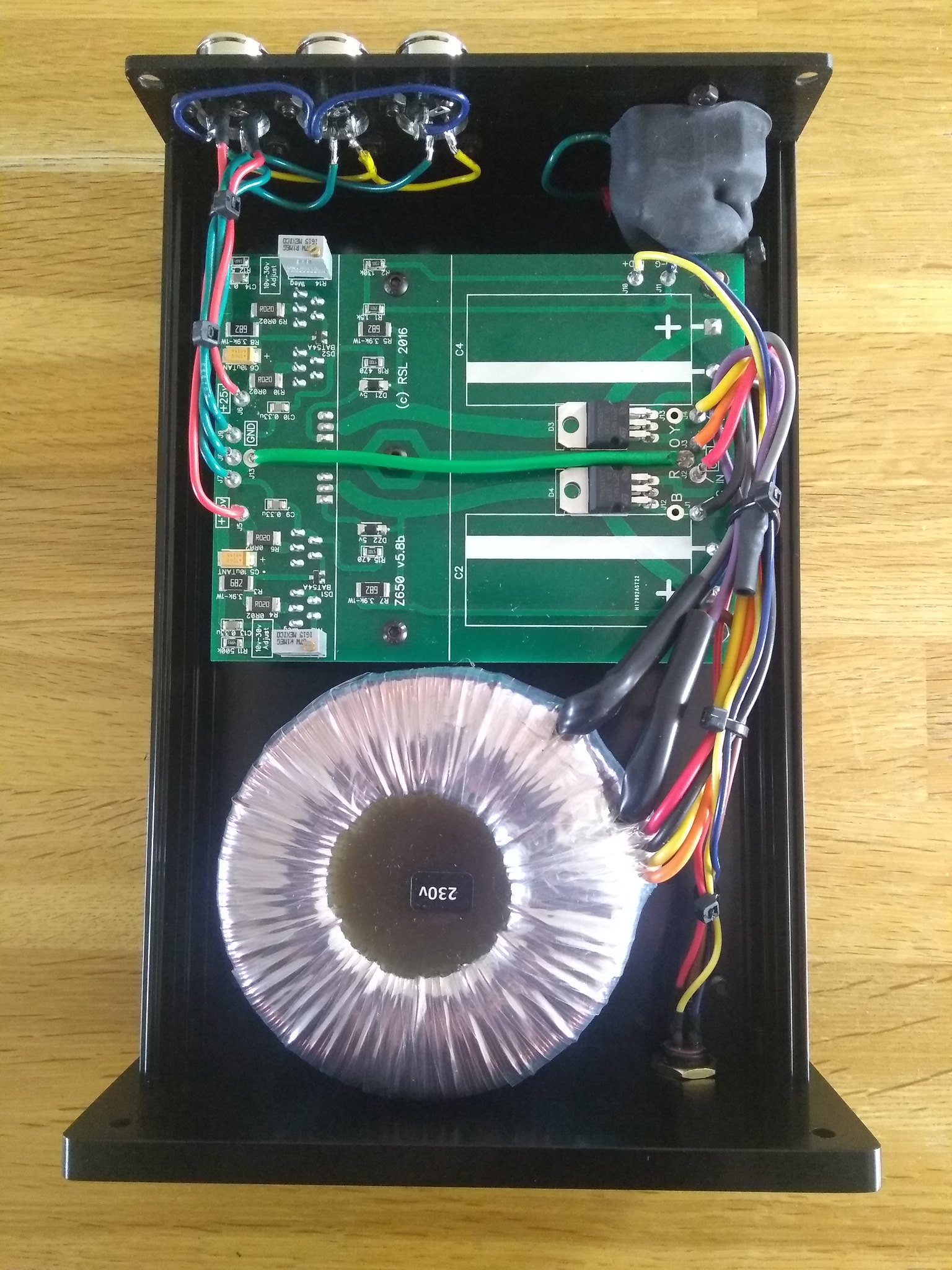I have previously taken Kit Ryan of Ryan Sound Labs (RSL) up on his kind offers of loan equipment: the MagicPower plug in cards for Naim preamps in my 72 https://pinkfishmedia.net/forum/thr...ards-still-available-for-naim-preamps.229036/; and his phono stage https://pinkfishmedia.net/forum/threads/ryan-sound-lab-phono-preamp-review.228038/
I have bought the MagicPower upgrades and would love a phono stage but ne upgrade at a time ...
I was pleased to recieved an email from Kit suggesting I might like to try something new, his ZapCap power supply - a replacement for a Hicap. Yes please ...
I will post some photos later but, spoiler alert, the photos will be my poor efforts on a cheapo phone but I know people will like to see, in the meantime I would say it looks a lot like the phono stage you can see on the RSL www site http://ryansoundlab.com/
It is a smaller than a Hicap, still a weighty item, comprising a toroidal transformer Kit has carefully selected for the sound he is looking for, and his PSM-2 power supply module http://ryansoundlab.com/index.php?main_page=product_info&cPath=13&products_id=22 all packed in the same style of case as the phono stage. It has a standard IEC socket and 3 DIN sockets on the rear. The 3 DIN sockets provide indentical wiring to the first 3 DIN sockets on a Hicap. If you need the 4th Hicap socket (and to be honest I don't know what it is for!) then this is not the power supply for you.
The loan kit comes with a standard UK IEC mains lead that fits very snuggly in the back of the ZapCap. The front has a blue LED lit power button. Nothing much to see but in my opinion well made, solid, and definitely not a flatcap style PSU full of air. It did not come with a SNAIC so I reused my existing cables.
My existing system is a Naim 72/Hicap/NAXO/Hicap/2x250/SBLs with the Hicap on the 72 running an Avondale TRP4 and using Avondale power only wiring from that to the 72 and signal only wiring from the 72 to the NAXO Hicap. Flashback cables. NACA5 speaker cables.
Replacing the Hicap/TPR4 with the ZapCap I listened to a few LPs, playing a track with the Hicap/TRP4 then with the ZapCap and vice versa. Bit of a faff but if I can't tell a difference AB (sighted I appreciate but please that is another thread!) then I am not interested.
I have to say I was surprised, when I did this with a stock Hicap and a Hicap/TPR4 I could not hear much difference, to me they sound much of a muchness. I thought perhaps I have cloth ears, or maybe the Avondale power only wiring to the 72 reduces the impact of the TPR4, anyway it certainly wasn't worse than the stock Hicap so I never reversed the mod, can't say I thought it much better either. Well the ZapCap has clearly audible differences.
Perhaps the most noticable difference is a tightening in the bass, I had never thought of the Hicap/TPR4 as having a bloom in the bass or being at all soggy, but it is in comparison with the ZapCap. Like the MagicPower cards, there is a sharpening to dynamics, tightening in the bass, and something we flat earthers try to ignore: if you sneakingly do like a bit of width to your soundstage, I feel the ZapCap gives you a bit more.
So how does Kit do this? Kit attributes the differences to several things:
The transformer is I believe a 120W item, certainly smaller, nothing like the size of the Hicap, Kit assures me the Hicap is totally over engineered and that this actually leads to some of the audible differences.
The ZapCap runs modern regulators, in parrallel too, not old school LM317s.
The ZapCap uses a pair of 10,000uf/50v Nichicon Audio Grade KW capacitors rather than the monsters that Kit refers to as computer caps (!!!) in the Hicap.
These three elements have been tried and tested by Kit (I notice the PCB has gone through many many revisions too!) to produce the ZapCap.
I understand that the ZapCap I have is soon to be called on for others to try and that it is intended as a loan unit in the same way Kit has provided loans of the MagicPower and phono stage. If you have a Naim item that can be powered from a Hicap, I would suggest you owe it to yourself to take Kit up on his kind offer of a loan of the ZapCap and see if you like what it does.
Any errors here are my own and I am sure Kit can correct me. I have tried to do justice in a few words to his work, but of course it is just my point of view. I get nothing from Kit but good service and the same loan items you too can sign up for.
The ZapCap deserves an audition.
I have bought the MagicPower upgrades and would love a phono stage but ne upgrade at a time ...
I was pleased to recieved an email from Kit suggesting I might like to try something new, his ZapCap power supply - a replacement for a Hicap. Yes please ...
I will post some photos later but, spoiler alert, the photos will be my poor efforts on a cheapo phone but I know people will like to see, in the meantime I would say it looks a lot like the phono stage you can see on the RSL www site http://ryansoundlab.com/
It is a smaller than a Hicap, still a weighty item, comprising a toroidal transformer Kit has carefully selected for the sound he is looking for, and his PSM-2 power supply module http://ryansoundlab.com/index.php?main_page=product_info&cPath=13&products_id=22 all packed in the same style of case as the phono stage. It has a standard IEC socket and 3 DIN sockets on the rear. The 3 DIN sockets provide indentical wiring to the first 3 DIN sockets on a Hicap. If you need the 4th Hicap socket (and to be honest I don't know what it is for!) then this is not the power supply for you.
The loan kit comes with a standard UK IEC mains lead that fits very snuggly in the back of the ZapCap. The front has a blue LED lit power button. Nothing much to see but in my opinion well made, solid, and definitely not a flatcap style PSU full of air. It did not come with a SNAIC so I reused my existing cables.
My existing system is a Naim 72/Hicap/NAXO/Hicap/2x250/SBLs with the Hicap on the 72 running an Avondale TRP4 and using Avondale power only wiring from that to the 72 and signal only wiring from the 72 to the NAXO Hicap. Flashback cables. NACA5 speaker cables.
Replacing the Hicap/TPR4 with the ZapCap I listened to a few LPs, playing a track with the Hicap/TRP4 then with the ZapCap and vice versa. Bit of a faff but if I can't tell a difference AB (sighted I appreciate but please that is another thread!) then I am not interested.
I have to say I was surprised, when I did this with a stock Hicap and a Hicap/TPR4 I could not hear much difference, to me they sound much of a muchness. I thought perhaps I have cloth ears, or maybe the Avondale power only wiring to the 72 reduces the impact of the TPR4, anyway it certainly wasn't worse than the stock Hicap so I never reversed the mod, can't say I thought it much better either. Well the ZapCap has clearly audible differences.
Perhaps the most noticable difference is a tightening in the bass, I had never thought of the Hicap/TPR4 as having a bloom in the bass or being at all soggy, but it is in comparison with the ZapCap. Like the MagicPower cards, there is a sharpening to dynamics, tightening in the bass, and something we flat earthers try to ignore: if you sneakingly do like a bit of width to your soundstage, I feel the ZapCap gives you a bit more.
So how does Kit do this? Kit attributes the differences to several things:
The transformer is I believe a 120W item, certainly smaller, nothing like the size of the Hicap, Kit assures me the Hicap is totally over engineered and that this actually leads to some of the audible differences.
The ZapCap runs modern regulators, in parrallel too, not old school LM317s.
The ZapCap uses a pair of 10,000uf/50v Nichicon Audio Grade KW capacitors rather than the monsters that Kit refers to as computer caps (!!!) in the Hicap.
These three elements have been tried and tested by Kit (I notice the PCB has gone through many many revisions too!) to produce the ZapCap.
I understand that the ZapCap I have is soon to be called on for others to try and that it is intended as a loan unit in the same way Kit has provided loans of the MagicPower and phono stage. If you have a Naim item that can be powered from a Hicap, I would suggest you owe it to yourself to take Kit up on his kind offer of a loan of the ZapCap and see if you like what it does.
Any errors here are my own and I am sure Kit can correct me. I have tried to do justice in a few words to his work, but of course it is just my point of view. I get nothing from Kit but good service and the same loan items you too can sign up for.
The ZapCap deserves an audition.


 IMG_20190904_133330587
IMG_20190904_133330587 IMG_20190904_132937236
IMG_20190904_132937236 IMG_20190904_133019576
IMG_20190904_133019576 IMG_20190904_132953407
IMG_20190904_132953407 IMG_20190904_133644281
IMG_20190904_133644281